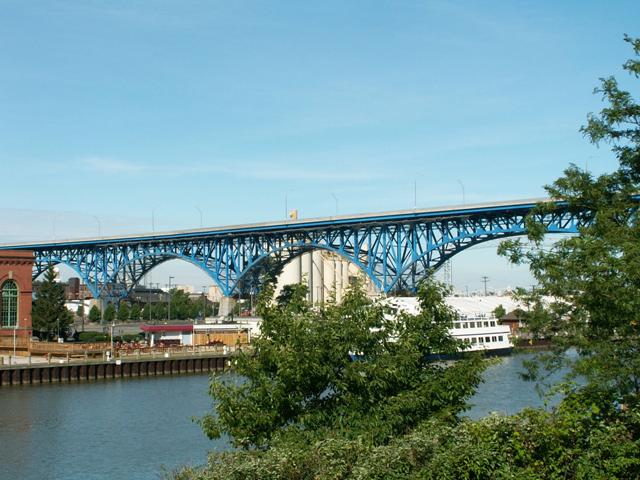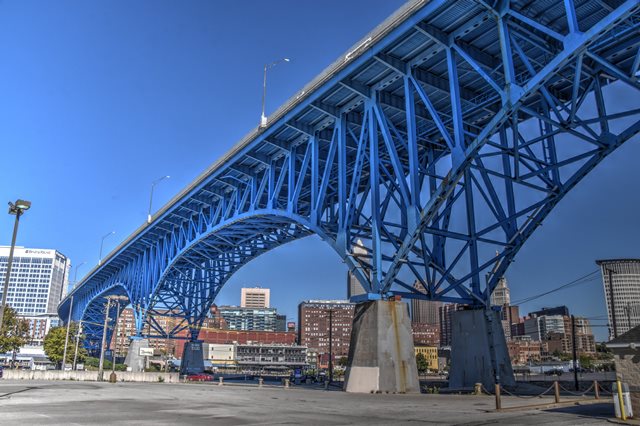We Recommend:
Bach Steel - Experts at historic truss bridge restoration.
Main Avenue Bridge
Cleveland Memorial Shoreway Bridge, Harold H. Burton Memorial Bridge
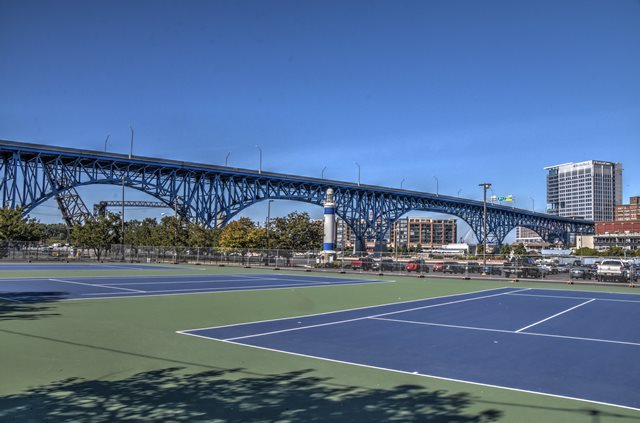
Primary Photographer(s): Nathan Holth
Bridge Documented: June 24, 2007, and October 1, 2021
Main Avenue (Cleveland Memorial Shoreway) Over Cuyahoga River
Cleveland: Cuyahoga County, Ohio: United States
Metal Cantilever Rivet-Connected Pratt Deck Truss, Fixed and Approach Spans: Metal Continuous Rigid-Frame, Fixed
1939 By Builder/Contractor: Bethlehem Steel Company of Bethlehem, Pennsylvania and Engineer/Design: Wilbur J. Watson and Associates of Cleveland, Ohio and Fred L. Plummer
2007
400.0 Feet (121.9 Meters)
8,000.0 Feet (2438.4 Meters)
82 Feet (24.99 Meters)
10 Main Span(s) and 30 Approach Span(s)
1800035

View Information About HSR Ratings
Bridge Documentation
Until 2007, this bridge was the longest bridge in the state. The recent completion of the cable-stayed bridge in Toledo, which is 8800 feet is now the longest. However, this bridge can still be considered the longest historic bridge in Ohio. The total structure length of this historic bridge including ramps is 8000 Feet / 1.5 Miles (2438.4 Meters / 2.4 Kilometers). The main structure alone is listed as 6580 Feet / 1.25 Miles (2005.6 Meters / 2 Kilometers). The bridge's clearance over the river is 100 Feet (30.5 Meters).
This bridge is a significant example of a deck cantilever structure, and represents a significant engineering achievement of the time. Five people were killed during the construction of this bridge.
This bridge is also significant for association with Federal Depression public works funding programs, something shared by a number of Cleveland bridges.
In 2007, the bridge was undergoing a repainting project, which suggests that the future for this historic bridge is bright. Previous projects dated to 1992 and 1978.
The bridge consists of the following spans from east to west. Plate girders, continuous over four spans, for the lakefront ramp, length 859.6 feet. Eight "continuous cantilever" riveted rigid frames for the eastern approach from West 3rd street to West 9th street, length 1200.8 feet. Continuous beams on rigid frame bents plus one simply supported truss for the eastern approach from West 9th street to "Pier 1O," length 698.8 feet. Ten "continuous cantilever" trusses, length 2519.7 feet. Four spans of continuous reinforced concrete beams on concrete rigid frames, length 180.4 feet. Riveted plate girder for the West 25th street overpass, length 88.6 feet. Continuous riveted rigid frames for a "subway ramp" overpass, length 226.4 feet. Continuous barrel-type concrete rigid frames for the West 28th street subway ramp overpass, length 55.7 feet. Three-span welded rigid frame bridges for the West 28th street overpasses, length 120 feet.
The bridge's complex design features at least five horizontal curves and severa vertical curves. The bridge cost $7,200,000 including $1,600,000 in land acquisition.
At the time, the use of v-lacing and lattice was common. While today these elements of historic bridges may be seen as intricate, beautiful geometry dissimilar to the simplicity of modern bridge design, at the time this bridge was built, lacing was seen as "old fashioned" and in the interest of making the bridge look modern, its designers eliminated the use of v-lacing and lattice in bridge members.
View Archived National Bridge Inventory Report - Has Additional Details and Evaluation
View Historical Articles About This Bridge
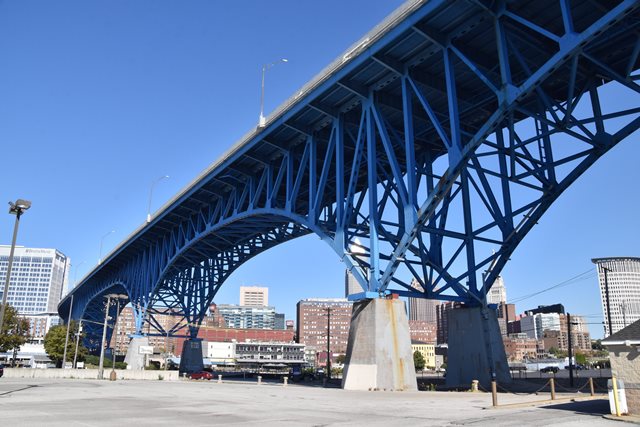
Above: View beside bridge. The far span visible to the left is the river span.
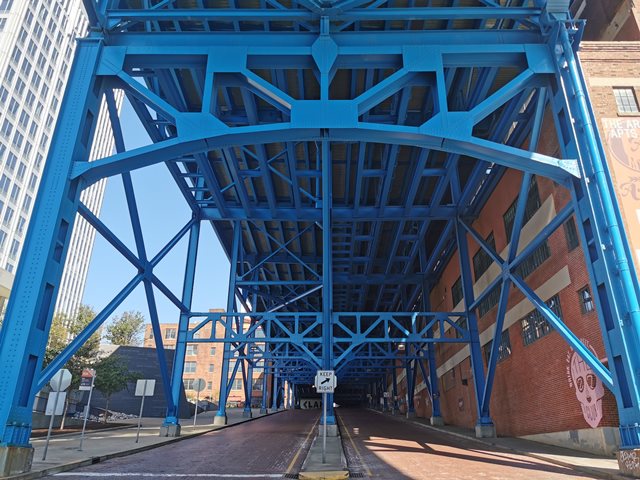
Above: View east of the river showing brick street under bridge.
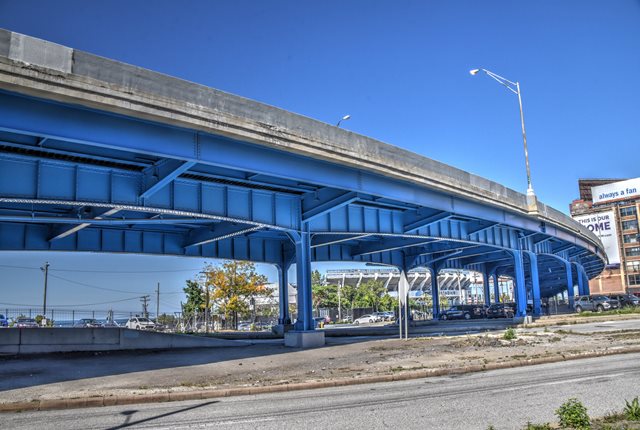
Above: Far eastern spans showing unusual steel rigid frame spans.
Above: Historical photo showing bridge construction. Source: Cleveland Memory.
Above: Historical photo showing bridge construction. Source: Cleveland Memory.
Above: Historical photo showing bridge construction. Source: Cleveland Memory.
Above: Historical photo showing bridge construction. Source: Cleveland Memory.
Above: Historical photo showing bridge construction. Source: Cleveland Memory.
Information and Findings From Ohio's Historic Bridge InventorySetting/Context The bridge was constructed as part of the Memorial Shoreway. It carries 6 lanes of traffic over the river and valley and is one of the major viaducts in the city. Physical Description The bridge's main spans are 10 continuous-cantilever deck trusses ranging in span length from 200' to 400'. The approach spans are continuous steel girder-floorbeam spans. One of the girder-floorbeam spans at the west end is over 270' long, which was then the longest span girder built in America. Integrity Has integrity. Summary of Significance The 1940 cantilever truss bridge was determined eligible in 2002 as part of rehabilitation planning. The Main Avenue bridge, which was built under the auspices of the WPA, is significant as the central feature of
Cleveland's urban regional traffic plan, one of the earliest in the nation adopted in the early 1930s. The route was intended to relieve city streets of cross-town and through traffic. The truss itself is in the tradition of
cantilever trusses dating to the early 20th century and followed on the heels of Wilbur Watson's successful 1932 Lorain-Carnegie Bridge. Justification The bridge is one of 11 remaining examples of the design used for long, major crossings of both deck and thru trusses. They date from 1922 through the interstate era. This is not the most significant example. The bridge has moderate significance. Bridge Considered Historic By Survey: Yes |
This bridge is tagged with the following special condition(s): Unorganized Photos
![]()
Photo Galleries and Videos: Main Avenue Bridge
Bridge Photo-Documentation
A collection of overview and detail photos. This photo gallery contains a combination of Original Size photos and Mobile Optimized photos in a touch-friendly popup viewer.Alternatively, Browse Without Using Viewer
![]()
Additional Unorganized Photos
Original / Full Size PhotosA supplemental collection of photos that are from additional visit(s) to the bridge and have not been organized or captioned. This gallery offers photos in the highest available resolution and file size in a touch-friendly popup viewer.
Alternatively, Browse Without Using Viewer
![]()
Additional Unorganized Photos
Mobile Optimized PhotosA supplemental collection of photos that are from additional visit(s) to the bridge and have not been organized or captioned. This gallery features data-friendly, fast-loading photos in a touch-friendly popup viewer.
Alternatively, Browse Without Using Viewer
![]()
Maps and Links: Main Avenue Bridge
Coordinates (Latitude, Longitude):
Search For Additional Bridge Listings:
Bridgehunter.com: View listed bridges within 0.5 miles (0.8 kilometers) of this bridge.
Bridgehunter.com: View listed bridges within 10 miles (16 kilometers) of this bridge.
Additional Maps:
Google Streetview (If Available)
GeoHack (Additional Links and Coordinates)
Apple Maps (Via DuckDuckGo Search)
Apple Maps (Apple devices only)
Android: Open Location In Your Map or GPS App
Flickr Gallery (Find Nearby Photos)
Wikimedia Commons (Find Nearby Photos)
Directions Via Sygic For Android
Directions Via Sygic For iOS and Android Dolphin Browser
USGS National Map (United States Only)
Historical USGS Topo Maps (United States Only)
Historic Aerials (United States Only)
CalTopo Maps (United States Only)






